Step-by-step instructions for forcing onions for herbs at home and on the site
Onions are a source of fiber, vitamins and phytoncides. The plant is grown all year round in open ground or greenhouses, the vegetable is especially appreciated in the off-season and in winter.
The article will tell you how to properly grow onions on a feather at home, in a greenhouse and in the open field.
The content of the article
- What is onion forcing
- What bulbs are suitable for this
- Methods for forcing onions on a feather
- Forcing in the open field
- Instructions for forcing onions on a feather
- How to speed up the growth of onions for greens
- Features of winter, spring, summer and autumn distillation
- Harvesting
- Forcing onions on an industrial scale
- Conclusion
What is onion forcing
Forcing onions - a set of measures for accelerated plant growth for quick greens production... Growth rate and product quality are highly dependent on the amount of incoming nutrients, which can be controlled in open and closed ground.
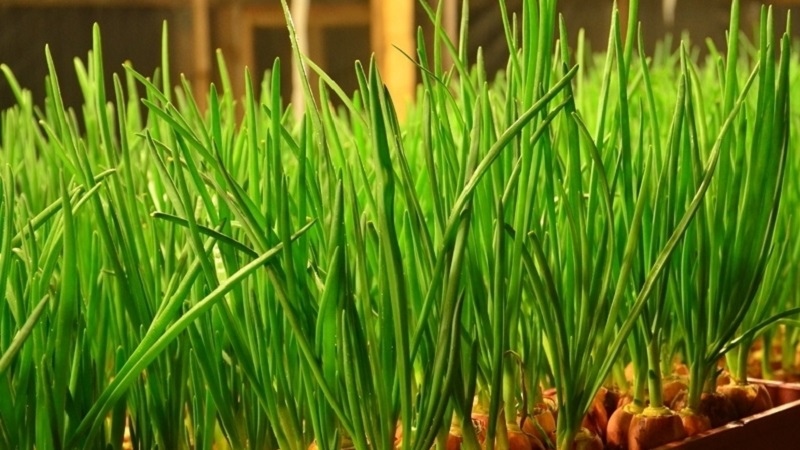
What bulbs are suitable for this
For growing onions for greens, the heads of the autumn harvest are suitable, dry and healthy, no damage.
The best varieties
The largest yield is given by multi-primordial varieties onionsthat have multiple kidneys.
To check, the head is cut across and their number is determined. Good specimens have 3 or more primordia.
Most popular varieties:
- Arzamas local - mid-season, cold-resistant, damaged by onion fly, unstable to peronosporosis;
- Local Bessonovsky - early maturing, with 2-3 primordia, round-flat heads, susceptible to infection with downy mildew;
- Rostov improved - early maturing, 2-3 growth buds, cold-resistant, relatively disease-resistant;
- Spassky - mid-season, primordia 7-10 are normal, hardy in cold weather, but susceptible to diseases and pests;
- Chernihiv - medium late, medium germinal, relatively resistant to pathogens, damaged by onion fly.
The average weight of the planting material is 30-50 g, the diameter is about 3-4 cm... The deformed and sprouted ones are also used, but they are planted separately.
Methods for forcing onions on a feather
Methods for forcing green onions are divided into 3 directions: in water, soil and any substrate.
In the ground
For distillation in the garden, turnips are planted with a diameter of 3-4 cm in spring, in March, or in the fall, in October.
For autumn planting, the earth is covered with a layer of humus, with the onset of heat, the mulch is removed and a film greenhouse is placed over the rows. The average consumption of planting material is 10-13 kg per 1 m².
In water
To germinate the bulbs in water, use a container of a suitable size, water at room temperature, with a small addition of mineral fertilizers.
A stand is made with holes of such a diameter that the heads go down and only the bases sink into the liquid. To prevent decay, 2 tablets of activated carbon are mixed into the liquid.
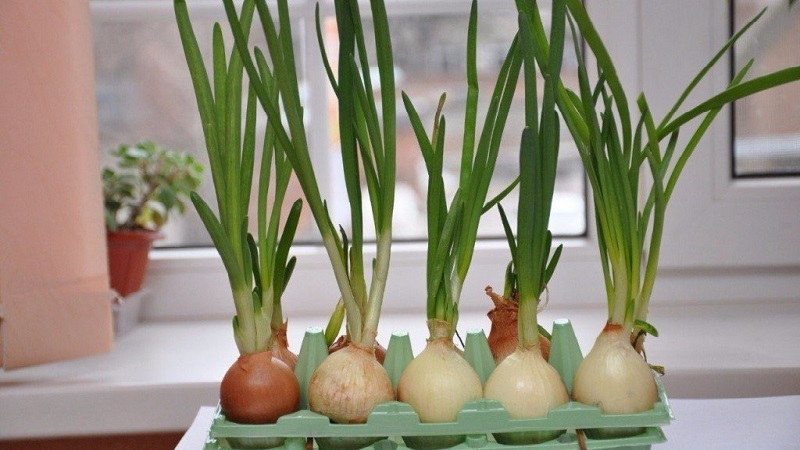
Leaves will appear in a week, and after 10-14 days, part of the crop is already suitable for cutting.
In sawdust
Sawdust is a perfectly suitable natural material that can be bought at a pet store... Before use, they are poured over with boiling water, spilled with a weak solution of potassium permanganate.
Wet sawdust is placed on the bottom of the container and the bulbs are tightly placed. Water as it dries, make a solution several times from 10 ml of hydrogen peroxide per 1 liter of water. Sawdust cannot be reused.
In hydroponics
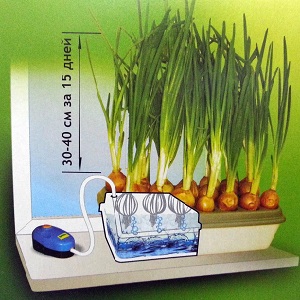 Hydroponics - growing technology plants without land.
Hydroponics - growing technology plants without land.
The method requires the following devices:
- light-tight containers with holes in the lid;
- water heater;
- compressor;
- fertilizer solution.
Optimum room temperature - + 25 ... + 27 ° С... The bulb is positioned so that the water only touches the bottom of the head. A water heater and a compressor are connected to enrich the environment with oxygen for 30-40 minutes.
Important! It is recommended to change the nutrient solution every 7-8 days.
The first 10 days the trays are kept in a dark place... Then, with a lack of natural light, phytolamps are installed. On the 13-15th day, they begin to harvest.
Forcing in the open field
Onions on greens in the open field are planted by bridge or tape method in spring or autumn... The first method saves space, since the sets are placed in dense rows. About 10 kg of raw materials are used for 1 m².
With the tape method make grooves at a distance of 10-15 cm from each other. In the fall, additionally sprinkle with a layer of rotted organic matter.
Seed method rarely used. It is economically unprofitable, since the harvest is obtained only after six months.
In greenhouses
There are a number of requirements for forcing in nurseries and greenhouses:
- a sufficient number of racks for the amount of planting raw materials;
- daylight and artificial lighting for at least 12 hours a day;
- irrigation system, air temperature control.
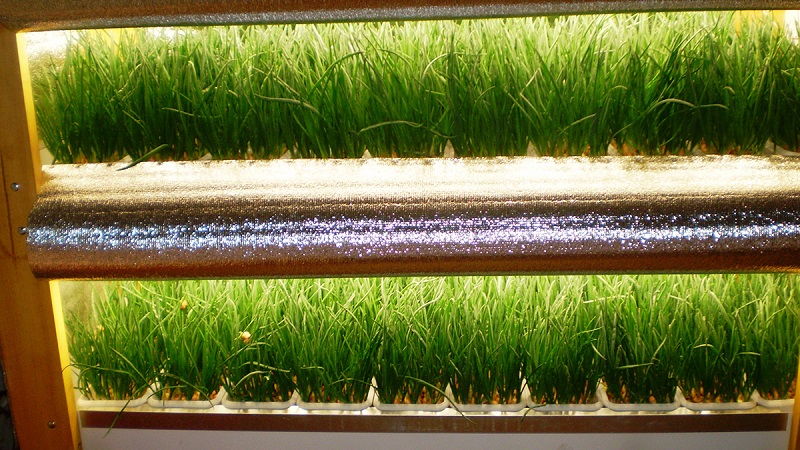
During the day, the optimum temperature is + 18 ... + 25 ° С, at night + 10 ... + 12 ° С.
Greenhouses are busy with onion planting from October to April, the last planting is in early spring. The substrate is prepared from peat, humus, earth and sand in a ratio of 3: 1: 1. One mixture is suitable for 3-4 harvests.
To save space, they are planted using the traditional bridge method... The first cut begins after 20 days. For an uninterrupted yield of products, onions are planted every 10 days.
On the windowsill
At home for growing greenery most often used window sills... Onions are sprouted in water or soil.
As containers are used special containers, unnecessary plastic trays, cans with small necks.
Important! In water, the heads can be awakened a few days later, which delays the production of greens by 2 weeks.
How to wake up onions for greens? The sevok is placed on the neck of a container or lid made of solid material with windows of suitable diameter. Only the root area is immersed in water - if you drown too much, then decay will begin.
Soil for onions is suitable for loose, organic content... The soil is poured into the container, completely moistened and the heads are laid out at a distance of 1 cm. Press lightly, but do not deepen. Water as it dries.
Instructions for forcing onions on a feather
Regardless of the chosen cultivation technology, the seed requires proper preparation, planting, adherence to the irrigation regime.
Preparing the bulbs
Sevok is prepared before planting:
- Warm up by soaking in hot water, up to + 50 ° C.
- Remove all the husk that lends itself.
- Processed in a solution of salt (50 g per 1 l of water) or potassium permanganate for 2 hours.
Correct fit
Sequence of actions for landing:
- The top is cut off from non-germinated specimens, less than 1/4 of the height.
- Lay out on the surface of the soil, deepening only the root area.
- Pour with water at room temperature.
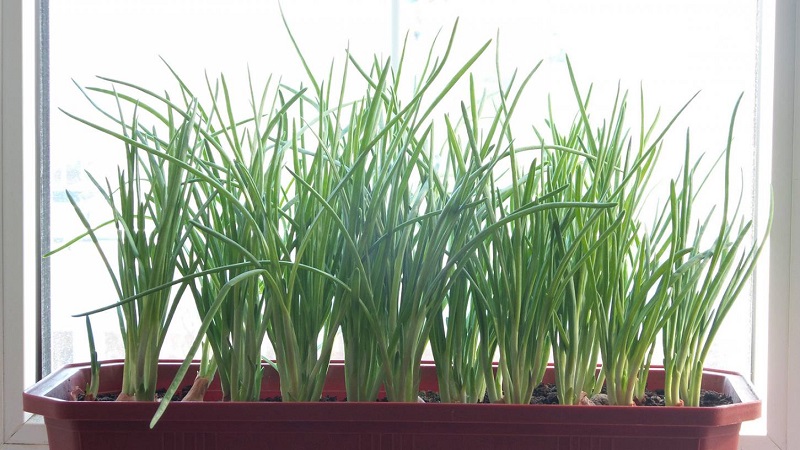
Care
Water sparingly, avoiding stagnant moisture, as this provokes rot. The dry crust on the ground is loosened, the leaves are periodically sprayed. In the heat, watered 1-2 times a day.
Feed after each cut nitrogen fertilizer, for example, urea or nitroammophos, at the rate of 1 g per 1 liter of water.
Optimal conditions
Onions are a cold-resistant culture, + 18 ... + 20 ° C is enough for it for normal development... At + 30 ° C, its growth stops. The optimum air humidity is 70-85%.
Most onion varieties are light-requiring, distillation takes 10-12 hours of continuous lighting. With a lack of it, the shoots will be pale green or yellow.
Diseases and pests
Planting onions in the open field is usually susceptible to pests and diseases.
Powdery mildew
Disputes are on turnips, which outwardly do not differ from healthy ones.... It appears 2 weeks after disembarkation with a white bloom. Preliminary disinfection of seed materials and the introduction of nitrogen fertilizers with phosphorus significantly reduce the risk of developing a fungus.
Onion mosaic
Caused by a virus carried by aphids and nematodes... Streaked spots appear on the leaves, then the entire bulb becomes infected. Affected plants are removed.
Onion fly
Late varieties suffer from it the most. To fight with onion fly water the ground, without getting on the feathers, with saline in a proportion of 2 g per 1 liter of water.
The procedure is repeated from the beginning of leaf growth to harvesting every 2 weeks.
Stem nematode
Thin white worms that feed on plant sap... Treatment of the planting material with water of + 40… + 50 ° C will kill the larvae.
How to speed up the growth of onions for greens
Soaking in hot water is the easiest way to make onions grow faster.... It will be helpful to immediately soak the set in diluted aloe juice. 1 tsp honey in 0.5 liters of water will also have a positive effect. Sevok is soaked in any solution for 10-12 hours.
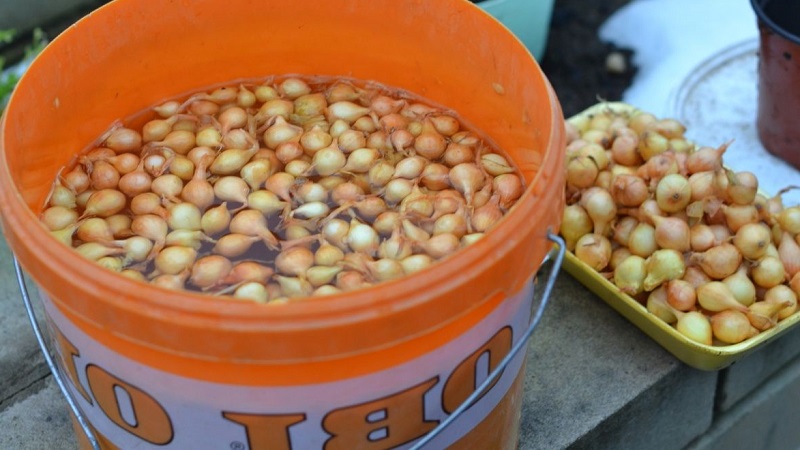
The use of stimulants
Stimulants will have a positive effect on onion growth:
- after planting, they are watered with a Heteroauxin solution to build up the root system.
- seedlings are sprayed with "Epin" according to the instructions.
- if necessary, they are treated with "Oxyogumate", which stimulates the development of even the weakest plants.
Features of winter, spring, summer and autumn distillation
In winter, it is recommended to take early ripening varieties for forcing... Abundant watering will be harmful, as it will provoke root rot. Particular attention is paid to lighting and heating.
Spring and summer open field onion season... Varieties of different harvest dates are used. Planting is carried out at intervals so that the cutting of the greenery is gradual. Since heating and additional lighting is not required, the cost of vegetables will be lower.
In the fall, lay the onion beds for next year and move on to greenhouse cultivation.
Harvesting
Cut the greens when the feather reaches 25-35 cm in length... If it is more than 40 cm, then it will begin to fade. They begin to harvest at the edges, as there are usually the most mature specimens.
Watering is stopped 2 days before the planned harvesting.
Forcing onions on an industrial scale
The business of growing green onions is always relevant - there is demand for the product all year round... Products can be obtained even in harsh climates, and strict adherence to the rules of planting and care minimizes losses.
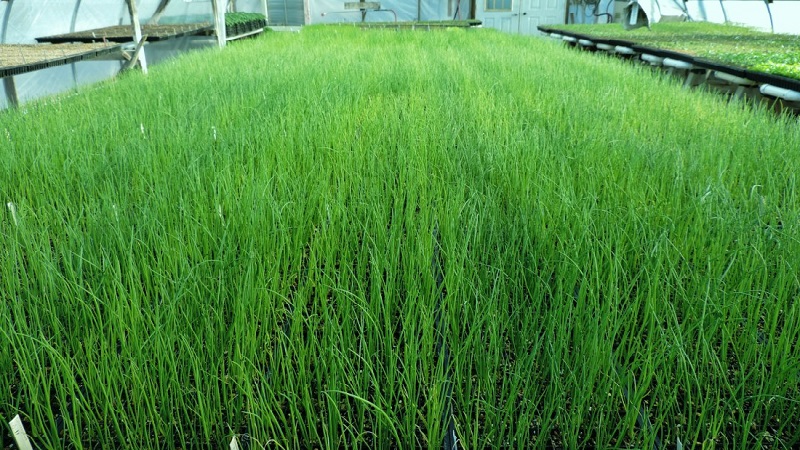
The profitability of such a business
The economic efficiency of forcing onions on feathers primarily depends on the season.... In summer it will be 50%, and in winter it will drop to 30% due to the cost of maintaining greenhouses. But if a good selling point is found, then the profitability can grow up to 200-300%.
The maximum prices are in April-Junesales leaps are also observed before the holidays.
To begin with, it is worth planting a trial batch in August-September and trying to implement the project. A successful result will pay off the investment and provide an opportunity for scaling.
Conclusion
Onions are an unpretentious plant, successfully cultivated in the beds and at home in different containers. The selection of the best specimens for planting and the observance of agricultural techniques are guaranteed to recoup the labor costs. When planning a green onion business, demand is initially estimated and sales are planned.
You can sprout onions in toilet paper. The good way: no debris, no smell.